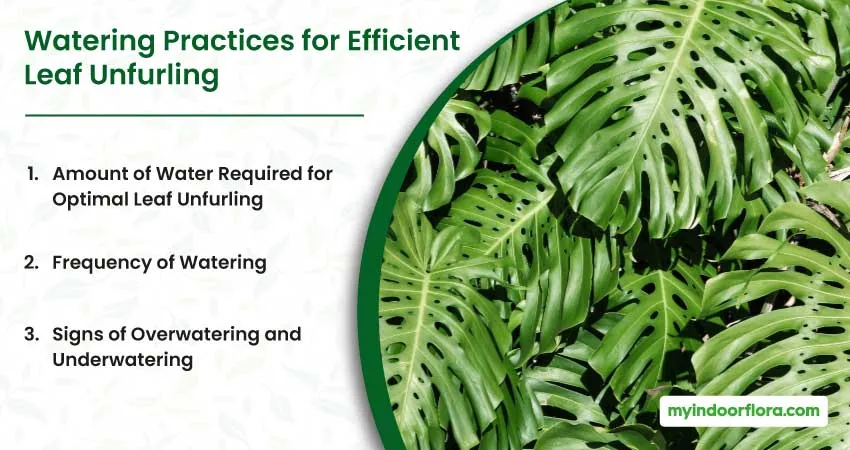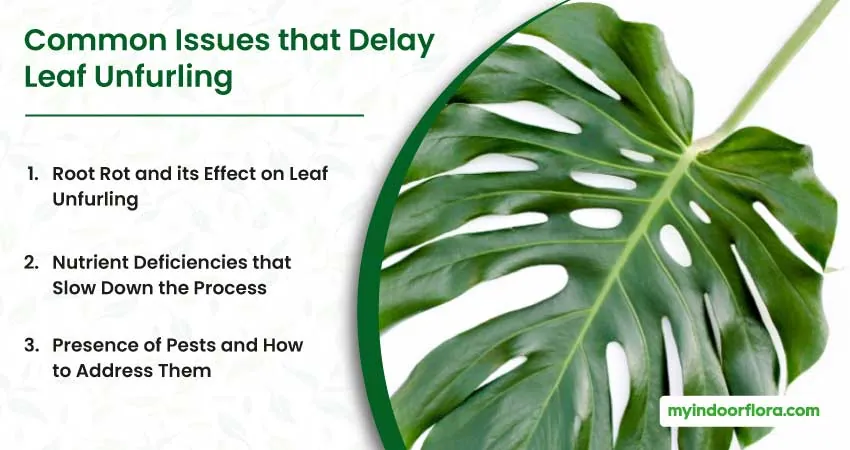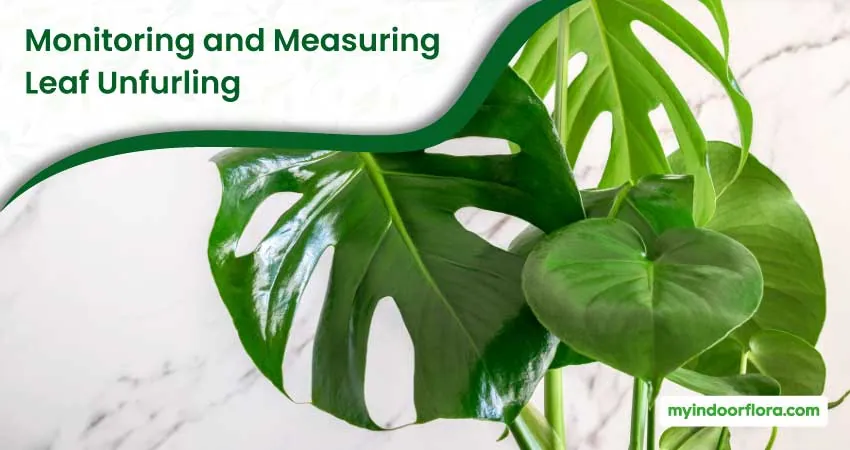Monstera plants, native to tropical rainforests of Central America, are known for their large, glossy leaves that often have natural holes or fenestrations. These plants are a popular choice for interior decoration and are scientifically recognized for their unique leaf unfurling process. The Monstera leaf unfurling is a dynamic process influenced by an array of factors including temperature, humidity, and nutrition.
How long does it take for a Monstera leaf to unfurl? The average duration for a Monstera leaf to completely unfurl ranges from 7 to 21 days. This timeframe can vary based on environmental conditions, plant health, and care practices.
This article provides a comprehensive guide on the factors affecting the speed of Monstera leaf unfurling, including the role of environmental conditions, nutrition, and pruning. We’ll also cover methods for monitoring and measuring leaf unfurling, and share expert tips for maximizing the process. Armed with this information, you’ll be well-equipped to optimize the health and beauty of your Monstera plant.
What Is Monstera Leaf Unfurling?
Monstera leaf unfurling is the biological process by which a new leaf on a Monstera plant unfolds and expands to reach its full size and shape. This is a phased progression that involves the initial emergence of a leaf bud, followed by the slow unwrapping of the leaf from a rolled or folded state.
The average timeframe for a Monstera leaf to completely unfurl ranges from 7 to 21 days, depending on various factors such as environmental conditions, nutritional status, and overall plant health. The process is governed by cellular expansion and differentiation, influenced by plant hormones like auxins and cytokinins. It’s a crucial aspect of Monstera plant growth and a key indicator of the plant’s health and well-being.

Timeframe for Monstera Leaf Unfurling
When you notice the Monstera leaf beginning to emerge, it’s like watching a mystery unfold. How long does it take for the leaf to completely unfurl? This crucial question has both simple and nuanced answers. Let’s delve deeper into this mesmerizing process.
Average Duration for a Monstera Leaf to Unfurl
On the surface, it may appear that Monstera leaves unfurl fairly quickly. But the actual timeframe tends to fluctuate widely, ranging from 1 to 3 weeks. So, what accounts for this variance? Multiple factors can influence the speed of leaf unfurling, from environmental conditions to nutritional balance.

Here’s a more detailed look into the factors that can affect the unfurling timeframe, with a quantifiable impact on days.
| Factors Affecting Duration | Estimated Impact on Time (Days) | Explanation |
|---|---|---|
| Temperature | +/- 2-5 | Temperature out of the ideal range can slow down metabolic activities, affecting unfurling. |
| Humidity | +/- 1-4 | Lower humidity may lead to slower cellular expansion. |
| Nutrition | +/- 2-6 | Nutrient imbalances can lead to weaker leaves that take longer to unfurl. |
| Light | +/- 1-3 | Insufficient light slows down photosynthesis, leading to slower growth. |
| Water | +/- 2-4 | Both overwatering and underwatering can affect the plant’s health and slow down leaf unfurling. |
Statistical Comparison to Peers
To offer a comparative view, let’s examine the unfurling duration of Monstera leaves against other popular houseplants.
| Plant Type | Average Time for Leaf Unfurling (Days) |
|---|---|
| Monstera | 7-21 |
| Snake Plant | 30-60 |
| Pothos | 5-10 |
| ZZ Plant | 15-30 |
As you can observe, Monstera leaves take a moderate amount of time to unfurl compared to other common houseplants.
Environmental Conditions Affecting Unfurling Speed
Understanding the environmental factors that influence the speed of Monstera leaf unfurling is akin to being a detective. You need to examine various clues and piece together a cohesive picture. Here, we’ll dive into the environmental elements that can either speed up or decelerate this intricate process.
Role of Temperature in Leaf Unfurling
Temperature is a critical factor for any plant, and Monsteras are no exception. The ideal temperature range for Monstera plants is between 65-80°F (18-27°C). But what happens when the temperature wavers outside this range?
Influence of Extreme Temperatures
Extreme temperatures can have a drastic effect. For instance, temperatures below 65°F can lead to slowed metabolic activities, leading to longer unfurling times. On the flip side, temperatures above 80°F can cause increased transpiration rates, potentially leading to dehydration and consequently, slower leaf unfurling.

Temperature Control Strategies
| Strategy | Description |
|---|---|
| Indoor Temperature Control | Maintain indoor temperatures using thermostats or temperature-controlled environments. |
| Seasonal Adjustments | During winter, consider using a heating mat to maintain soil temperature. |
| Room Placement | Place your Monstera in a room where temperatures are more stable, avoiding areas like drafty windows or heat vents. |
Humidity’s Influence on the Process
Monsteras, being tropical plants, thrive in a humid environment—ideally between 60% to 80% relative humidity. But what if your living space doesn’t naturally have this level of humidity?
Impact of Low Humidity Levels
Low humidity can result in slower leaf unfurling due to reduced cellular expansion and increased transpiration rates. Leaves may appear crinkled or even cease unfurling altogether in extreme cases.
Strategies for Maintaining Ideal Humidity
| Strategy | Description |
|---|---|
| Humidifier | Use a humidifier near the plant to maintain the required humidity levels. |
| Pebble Tray | Place a tray filled with water and pebbles beneath the plant pot. As the water evaporates, it increases humidity. |
| Misting | Lightly misting the leaves can temporarily boost humidity. However, this should not be the sole method for maintaining humidity. |
Remember, the goal is to create the most conducive environment for your Monstera leaf to unfurl in the shortest amount of time. By understanding and optimizing these critical factors, you become more than just a plant owner—you become an informed caretaker.
Nutritional Requirements for Quick Leaf Unfurling
When it comes to Monstera plants, nutrition is more than just a supplementary concern—it’s pivotal. If you’ve ever wondered why some Monstera plants unfurl their leaves faster than others, the answer often lies in the nutritional balance. Let’s go beyond the basics to understand the science of nutrients and how they impact the speed of leaf unfurling.
Importance of Proper Fertilization
Fertilization isn’t a mere act of pouring some plant food into the soil. It’s an intricate ballet of nutrients that must be carefully orchestrated for optimal leaf growth.

Soil Analysis: The First Step in Proper Fertilization
Before you even think about fertilizing, it’s crucial to know what your soil is lacking. Soil tests can be an excellent first step, providing insights into the nutrient composition of your soil.
| Nutrient | Optimal Level in Soil |
|---|---|
| Nitrogen (N) | 20-30 mg/kg |
| Phosphorus (P) | 10-20 mg/kg |
| Potassium (K) | 30-50 mg/kg |
| Calcium (Ca) | 40-60 mg/kg |
| Magnesium (Mg) | 20-30 mg/kg |
The N-P-K Ratio: Breaking Down the Basics
In the world of plant nutrition, N-P-K is akin to the ABCs. This ratio defines the balance of Nitrogen, Phosphorus, and Potassium in fertilizers.
- Nitrogen (N): Essential for leaf growth and green color.
- Phosphorus (P): Important for root development, flower, and seed production.
- Potassium (K): Vital for overall plant health and disease resistance.
Specialized Fertilizers for Monstera
While general-purpose fertilizers can be used, specialized Monstera fertilizers are formulated to meet the plant’s unique nutrient requirements.
| Specialized Fertilizer | N-P-K Ratio | Benefits |
|---|---|---|
| Monstera Grow | 20-10-20 | Balanced for leaf and root growth |
| Tropical Boost | 15-30-15 | High phosphorus for root development |
| Green Vitality | 24-8-16 | High nitrogen for lush, green leaves |
Frequency and Methods of Fertilization
Understanding when and how to fertilize is just as crucial as knowing what to use.
Seasonal Adjustments in Fertilization
Monstera plants have different nutritional needs based on the season. During the growing season (spring and summer), they require more frequent fertilization, approximately every 4-6 weeks. In contrast, during the dormant season (fall and winter), fertilizing every 8-12 weeks is sufficient.
| Season | Fertilization Frequency |
|---|---|
| Spring | Every 4-6 weeks |
| Summer | Every 4-6 weeks |
| Fall | Every 8-12 weeks |
| Winter | Every 8-12 weeks |
Techniques for Effective Fertilization
- Top Dressing: Add a layer of compost or slow-release granular fertilizer to the top of the soil.
- Liquid Fertilization: Dilute liquid fertilizer according to package directions and apply during watering.
- Foliar Feeding: Spray diluted liquid fertilizer directly onto the leaves for quick nutrient absorption.
Watering Practices for Efficient Leaf Unfurling
Water is to plants what air is to humans—a lifeline. But much like humans don’t need to be in a wind tunnel to breathe efficiently, Monsteras don’t need to be drenched to grow well. So, what are the water requirements for a Monstera leaf to unfurl efficiently? Let’s dive in.

1. Amount of Water Required for Optimal Leaf Unfurling
The “how much” in watering is a balancing act. Not enough, and the plant goes thirsty, affecting leaf unfurling. Too much, and you risk root rot. So what’s the right amount?
- Small Plants (< 1 ft height): Approximately 1-2 cups of water
- Medium Plants (1-3 ft height): Approximately 1 quart of water
- Large Plants (> 3 ft height): Approximately 1-2 gallons of water
2. Frequency of Watering
When it comes to watering frequency, several factors play a role: the plant’s size, the environmental conditions, and even the time of year.
Seasonal Watering Patterns
| Season | Watering Frequency |
|---|---|
| Spring | Once a week |
| Summer | Once a week |
| Fall | Every 10 days |
| Winter | Every 2 weeks |
Role of Environmental Factors in Watering Frequency
Humidity, temperature, and even the type of pot you use can impact how often you need to water your Monstera.
| Environmental Factor | Impact on Watering Frequency |
|---|---|
| High Humidity | Decreases frequency |
| High Temperature | Increases frequency |
| Type of Pot | Porous pots need more frequent watering |
3. Signs of Overwatering and Underwatering
Knowing the signs can help you adjust your watering regimen effectively.
| Condition | Symptoms | Remedies |
|---|---|---|
| Overwatering | Yellow leaves, root rot | Reduce watering, improve drainage |
| Underwatering | Dry soil, brown leaf tips | Increase watering frequency, check for water retention |
Impact of Plant Age on Leaf Unfurling
The age of your Monstera plant isn’t just a number; it’s a lens through which various aspects of plant care, including leaf unfurling, should be viewed. Understanding the age-related dynamics can be a game-changer in optimizing the speed at which Monstera leaves unfurl.

Differences Between Young and Mature Monstera Plants
Young and mature Monsteras are like toddlers and teenagers—each has its own set of needs and quirks.
Leaf Morphology by Age
Young Monsteras often sport leaves that are smaller and less intricate. As the plant ages, the leaves get more extensive and develop the iconic splits and fenestrations that Monstera is famous for.
| Age of Plant | Typical Leaf Size | Fenestration |
|---|---|---|
| 0-1 Years | 3-6 inches | None |
| 1-3 Years | 6-12 inches | Minimal |
| 3+ Years | Over 12 inches | Extensive |
Metabolic Rates: Youth vs. Maturity
Young Monsteras typically have higher metabolic rates, meaning they grow more quickly and, consequently, their leaves unfurl faster. Mature Monsteras are more settled in their growth patterns and generally unfurl their leaves at a steadier, slower pace.
How Age Affects the Speed of Leaf Unfurling
Leaf unfurling isn’t a one-size-fits-all phenomenon. Several age-related factors can influence the speed of this process.
Hormonal Changes and Their Impact
Plants, like animals, experience hormonal changes as they age. In Monsteras, the hormone auxin plays a crucial role in cell elongation and differentiation, affecting the rate of leaf unfurling.
Nutrient Uptake Efficiency
As plants mature, their root systems become more developed, allowing them to absorb nutrients more efficiently. This can both speed up and slow down leaf unfurling, depending on the balance of nutrients available.
| Age of Plant | Nutrient Uptake Efficiency |
|---|---|
| 0-1 Years | Low |
| 1-3 Years | Moderate |
| 3+ Years | High |
Common Issues that Delay Leaf Unfurling
Sometimes, despite our best efforts, Monstera leaves seem to take forever to unfurl. If you find yourself in this predicament, it’s crucial to diagnose the problem accurately. Here are some common issues that could be delaying the leaf unfurling process.

1. Root Rot and its Effect on Leaf Unfurling
Root rot is like the flu for Monsteras—debilitating and tricky to handle. It’s often caused by overwatering and poor drainage, leading to a fungal infection in the roots.
Symptoms of Root Rot
- Foul-smelling soil
- Yellow or brown leaves
- Sluggish growth and delayed leaf unfurling
Remedial Measures for Root Rot
- Repotting the plant in fresh, well-draining soil
- Cutting away affected roots
- Treating with a fungicide formulated for root rot
2. Nutrient Deficiencies that Slow Down the Process
Just as a car can’t run without fuel, Monsteras can’t grow without proper nutrition. A lack of essential nutrients can significantly slow down the leaf unfurling process.
Common Nutrient Deficiencies and Their Signs
| Nutrient | Symptoms |
|---|---|
| Nitrogen | Pale green leaves |
| Phosphorus | Purple or dark green leaves, weak roots |
| Potassium | Yellow leaf edges |
| Calcium | New leaves die back or appear distorted |
| Magnesium | Older leaves turn red or purple |
Corrective Measures
- Soil testing to identify deficiencies
- Application of a balanced, slow-release fertilizer
- Foliar sprays for quick nutrient absorption
3. Presence of Pests and How to Address Them
Pests can be an unexpected obstacle in the leaf unfurling journey of your Monstera. Common pests like spider mites, mealybugs, and aphids can suck the life out of your plant, literally and metaphorically.
Identifying and Eliminating Common Pests
| Pest | Identification | Elimination Method |
|---|---|---|
| Spider Mites | Fine webbing, yellow leaves | Neem oil, insecticidal soap |
| Mealybugs | White cotton-like masses | Alcohol swabs, insecticides |
| Aphids | Small green or black bugs | Insecticidal soap, neem oil |
Role of Pruning in Leaf Unfurling
Pruning is far more than a cosmetic procedure for your Monstera plant. In essence, it’s an essential aspect of plant care that directly influences leaf unfurling. So, how does this work, and what are the best practices? Let’s delve in.
Why Pruning May be Necessary for Healthy Unfurling
The act of pruning serves multiple purposes, from redirecting energy to promoting new growth. When you remove dead or diseased leaves and stems, the plant can focus its energy more effectively on new leaf development and unfurling.
Pruning stimulates the plant’s hormonal balance. Cutting a stem or leaf triggers the plant to release hormones called auxins and cytokinins, which promote new cell growth and division.
When you prune, you’re essentially streamlining the plant’s vascular system. The nutrients and water that would have been distributed to the pruned parts can now be channeled more efficiently towards new growth, thereby potentially speeding up leaf unfurling.
Best Practices for Pruning Monstera Plants
Pruning isn’t a one-cut-fits-all deal; it needs to be done carefully and strategically.
Tools for Effective Pruning
| Tool Type | Best For |
|---|---|
| Hand Pruners | Small to medium-sized leaves |
| Lopping Shears | Thick stems and larger leaves |
| Micro-Tip Snips | Fine-tuning and small touch-ups |
Step-by-Step Guide to Pruning
- Sanitize Tools: Always begin by sanitizing your pruning tools to avoid transferring diseases.
- Identify Targets: Look for leaves that are yellow, brown, or have signs of diseases or pests.
- Make the Cut: Cut at a 45-degree angle to promote healing and new growth.
- Assess and Repeat: After making a few cuts, step back and assess the plant’s shape and balance before continuing.
When to Avoid Pruning
Certain times and conditions make pruning less than ideal.
- Dormant Season: Pruning during the plant’s dormant phase, typically in winter, can stress the plant.
- Disease: If your plant is already stressed due to disease or pests, hold off on pruning until it recovers.
Monitoring and Measuring Leaf Unfurling
The leaf unfurling process is not just fascinating to watch, but also valuable to understand. Monitoring and measuring leaf unfurling can provide critical insights into your Monstera’s health and needs.

Keen observation and the right tools can make the monitoring process both accurate and rewarding.
| Tool Type | What it Measures |
|---|---|
| Ruler | Leaf length and width |
| Calipers | Precision measurements |
| Camera | Visual documentation |
Keeping a detailed log can help you correlate leaf unfurling speed with changes in care or environmental conditions.
- Manual Journal: Note down measurements, date of first appearance, and date of full unfurling.
- Digital Tracking: Use spreadsheet software to create a more detailed and searchable record.
Setting Realistic Expectations for Leaf Unfurling
Understanding that each leaf is unique can set the stage for a less stressful and more enjoyable plant-care experience.
Factors Influencing Unfurling Speed
- Environmental Conditions: Humidity, temperature, and light can all impact the rate of unfurling.
- Nutritional Status: A well-fed Monstera is likely to unfurl its leaves more quickly than a nutrient-starved one.
Expert Tips for Maximizing Leaf Unfurling
For those looking to master the art and science of Monstera leaf unfurling, expert insights can offer that extra edge. Here are some advanced tips for maximizing the unfurling process.
Recommendations from Horticulturists and Plant Experts
Years of experience and research have led to some valuable guidelines.
- Consistency is Key: Maintaining consistent environmental conditions can dramatically improve leaf unfurling rates.
- Use of Growth Regulators: Some experts recommend the cautious use of plant growth regulators like gibberellic acid to enhance leaf unfurling.
Proven Methods for Accelerating Leaf Unfurling
While there’s no magic bullet, several strategies have proven effective.
- Optimal Nutrition: Use of controlled-release fertilizers specifically designed for Monsteras.
- Effective Pruning: Strategic removal of old or diseased leaves can divert energy towards faster leaf unfurling.
Myths and Misconceptions to Avoid
In the world of plant care, myths abound. Knowing what not to do is as important as knowing what to do.
- The Coffee Grounds Myth: Contrary to popular belief, coffee grounds are not a one-size-fits-all nutrient solution and can harm your Monstera.
- The ‘More Light’ Misconception: More light does not necessarily mean faster growth. In fact, too much direct light can harm your Monstera.
By applying these advanced techniques and insights, you’ll be well on your way to becoming a Monstera leaf unfurling maestro.
